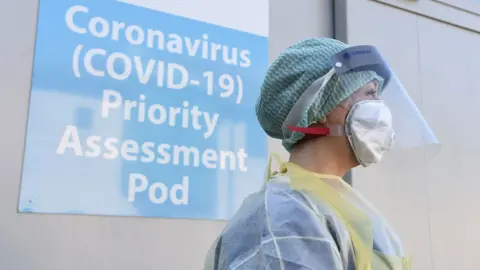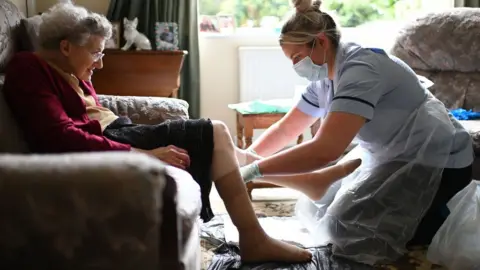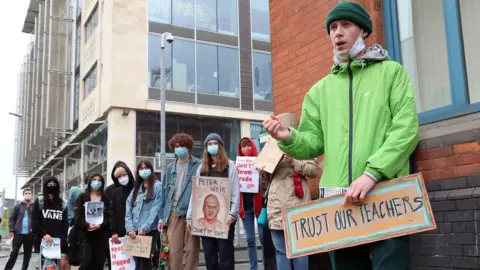Coronavirus in Northern Ireland - six months on
 PA Media
PA MediaNorthern Ireland's first case of coronavirus was confirmed by the Public Health Agency in February.
Within a month, the first death had been announced. To date, a total of 560 deaths have been recorded by the Department of Health.
Up to Friday, 21 August, there have been a total of 871 Covid-19 related deaths, according to the Northern Ireland Statistics & Research Agency (Nisra).
The department's numbers mostly reflect hospital deaths and where patients had tested positive for the virus, whereas Nisra's weekly figures cover all fatalities in which coronavirus has been recorded on the death certificate.
BBC News NI looks back at the past six months when coronavirus dominated the headlines.

The first case of Covid-19 in Northern Ireland was diagnosed in a woman on 27 February 2020. She had been in northern Italy and flew in to Dublin Airport before travelling on to Northern Ireland.
Authorities said the patient had shown a presumptive positive result, which would be confirmed by a lab in England.
The first coronavirus-related death in Northern Ireland was confirmed on 19 March 2020.
The elderly man, who had an underlying medical condition, was being treated in a hospital in the greater Belfast area.
 PAcemaker
PAcemakerAt this early stage of the pandemic, Health Minister Robin Swann described the scale of the impending surge as being "of biblical proportions".
He said there could be 14,000 - 15,000 deaths, adding, "that is the nightmare, worst-case scenario".
With schools in the Republic of Ireland closing on 13 March, the first sign of divisions appeared within the Northern Ireland Executive over its handling of the crisis.
Twelve hours after the executive issued an agreed response to keep schools open, Sinn Féin Deputy First Minister Michelle O'Neill broke ranks and insisted that schools should close immediately.
All schools in Northern Ireland were closed on Monday 23 March and remained shut for five months.
Widespread stockpiling of foodstuffs became a matter of concern in the early weeks of lockdown with Economy Minister Diane Dodds describing it as "quite severe".
 Pacemaker
PacemakerOn 28 March, the executive announced an unprecedented set of emergency regulations that brought Northern Ireland into line with the rest of the UK.
They included powers for the police to act against people who left their homes without a "reasonable excuse" and to issue fixed penalty fines of up to £5,000.
Business owners could also be fined if they refused to shut up shop.
As the public grappled with new terminology, such as the R number and community transmission, it was the supply of PPE, personal protective equipment, that grabbed the headlines.
As early as 2 April, the health unions demanded answers from Robin Swann and the Department of Health on the apparent lack of PPE.
On 11 April, the minister announced that he had made a formal request to the Army for assistance to deal with the pandemic.
 PA/Daniel Leal-Olivas
PA/Daniel Leal-OlivasGovernment actions to shore up the health service at the beginning of the pandemic had centred on increasing bed capacity on intensive care wards, the supply of ventilators and the establishment of Nightingale hospitals.
However, it was nursing homes that emerged as one of the the hidden stories of the Covid crisis in Northern Ireland.
At the end of May, the Northern Ireland Statistics and Research Agency (Nisra) revealed that nursing home residents had accounted for more than half of Covid-19 related deaths in Northern Ireland.
At the peak, 72 care homes experienced a Covid-19 outbreak. An outbreak is defined when two or more cases in a care home are confirmed within a 14-day period among either residents or staff.
 Pacemaker
PacemakerDivisions appeared again at the top of the executive when, at the end of June, Deputy First Minister Michelle O'Neill attended the funeral of leading republican Bobby Storey.
The Sinn Féin vice-president issued an apology, saying she was "sorry for grieving families experiencing more hurt", but insisted that she had acted within the executive's coronavirus guidelines.
 Pacemaker
PacemakerIn August, in an effort to suppress the virus, the executive announced face masks would become mandatory in shops and other enclosed public spaces.
With exams cancelled due to the Covid-19 lockdown, A-level results were calculated using a mixture of teacher-predicted scores and a Department of Education algorithm.
Education Minister Peter Weir was forced into an embarrassing u-turn when more than a third of teacher-estimated grades were lowered in the final results issued on 13 August.
Four days later, he announced that students would be awarded the highest grade either predicted by their teacher or awarded using the algorithm.
'Still the biggest health crisis'
As the summer drew to a close and schools begin the widespread process of reopening for the first time in five months, Health Minister Robin Swann warned that the pandemic had still not gone away.
On 27 August, although hospital admissions and deaths were much lower than at the early stages of the pandemic, Mr Swann announced that the R rate was 1.3 and hospital admissions were rising.
NI's chief scientific adviser Prof Ian Young said that the cases of the virus per day had increased "more than tenfold since early July".
"At present most of those cases are in younger people and show hospital admissions and bed occupancy are growing slowly," he added.
"Nonetheless it is clear that the virus is spreading and is everywhere in Northern Ireland."
Mr Swann said he would be looking to the executive to tighten up regulations.
"This is the still the biggest health crisis we have had to face," the minister added.
Coronavirus statistics for Northern Ireland
Official figures collected over the past six months give an indication of the development of the pandemic in Northern Ireland.
These statistics have come from the Department of Health and reflect those who have had a confirmed positive test for Covid-19.
Cases of coronavirus began to rise in Northern Ireland, and the number of daily positive tests peaked in mid-April, reaching more than 150 on 19 April.

The number of coronavirus-related deaths started to rise in late March, peaking towards the end of April when 19 deaths were recorded on one day.

A total of 6,964 cases were confirmed on 27 August, with more than a tenth of those being diagnosed in the previous 14 days.

Since March, 560 coronavirus-related deaths have been recorded by the Department of Health, with ten deaths in the past 60 days.

Over the last six months, people aged between 20 and 59 have accounted for almost half the total number of cases.

More than half the 560 deaths recorded were those aged 80 and over.

The number of cases and deaths have been recorded by council area, geographically.
All 11 councils saw a similar rise and fall in cases over time with the most cases occurring in Belfast City Council area.

The number of people being admitted to hospital on a daily basis peaked in the first week of April, with more than 40 people being admitted.

The total number of people being treated in hospital as inpatients was 346 on 8 April.
Admissions to intensive care followed a similar pattern, with the peak number of patients being treated in intensive care being 54 - that on was on 10 April.

